
Nowadays, leather has found their ways into many homes in the world as it offers timeless elegance and comfort to many people. The materials used in leather are breathable making it cool to sit during the summer months and toasty warm in the winter time. With the increasing popularity of leather, many furniture and fixture are now made from leather. Leather furniture includes sofa-set, loveseats, tables, beds, straight chairs, and leather recliners.
Most often, we tend to overlook cleaning the furniture while we are paying a lot of attention to cleaning the floors and carpets. The careless disregard of this furniture can turn them into a vintage piece much earlier than it is supposed to. With the proper care, leather furniture will even last for two decades making it a sound investment to many price-conscious individuals. Leather is made from natural material that is why it appears more beautiful as it age. Leather lasts much longer than other upholstery.
Understanding the type of leather helps you determine the type of leather you are working with as well as how to treat it and methods to avoid. Leather furniture uses many different types of leathers and has undergone different processes. The four primary types of leather are full-grain, top-grain, corrected grain, and split leather. The common sources of leather materials are cattle, sheep, cows, pigs, stingrays, and ostriches.
Full-grain leather is considered the priciest among the types of leather. They refer to hides that have not been sanded, buffed, or snuffed to remove imperfections. This type of leather is commonly used to make high quality leather furniture and footwear. Because full-grain leather are minimally treated and processed, it tends to be the most durable material. Many claim that wearing clothing made from full-grain gets more comfortable as it gets older. Full-grain leather are dyed to make the most natural looking leather and retains the unique surface characteristic, this is referred to the aniline finish.
Top-grain leather is another favorable type of leather but typically inexpensive than full-grain. Unlike full-grain, its surface has been sanded and treated with a light coat to the surface which results in a colder, plastic feel with less breathability.
Corrected-grain leather is significantly processed with more chemicals and paints. This produces leather that is not as soft as the full-grain but is way too cheaper than the minimally treated one.
Split leather is the process of splitting the thicker hide to create a piece of leather out of its extra thickness. Split leather then has an artificial layer applied to the surface of the split.
A regular cleaning is a must
A weekly cleaning of your leather furniture is recommended to ensure that they still look great over the years. Depending on the usage, a piece of dry cloth will work on lightly used furniture while those that are heavily used will need to be vacuumed with a brush attachment. This will ensure that the surface of the leather is free from various elements such as dust and dirt that builds up on the leather.
Minimize the use of water, cleaning solvents, soaps or ammonia
If you accidentally spill food or drinks on your leather furniture then it should be cleaned immediately with a clean, soft, damp cloth and avoid the use of excessive water and harsh soaps as it disintegrates the surface and speeds up the cracking and breaking process. In addition to, strong solvents or ammonia will not only cause cracks on the surface but also they tend to bleach the leather, leaving a permanent stain on the spot. If the stain is persistent enough then refer to the manufacturer as to what type of cleaning method recommended for your leather furniture. Generally, you can use mild leather cleaner on worst cases but make sure to apply a preservative to that area.
Keep the leather away from direct heat sources
Sunlight is the best enemy for your leather furniture. A direct exposure to sunlight and other heat sources such as fireplaces, heat registers, and portable heaters will cause the leather to dry and crack while losing its color. Keep your leather furniture at least two feet away from direct heat sources.
Proper Conditioning
Judiciously conditioning the leather once in every 6 to 12 months keeps the leather from drying out and developing cracks. There’s an array of leather conditioners found in many car accessories shops or furniture stores but the choice of brand depends on the type of leather you have. Before investing in a particular leather conditioner, make sure to check the type of leather used in your furniture. You can check the product information on the care tag or better yet call the manufacturer. Additionally, choose conditioners that are not too strong to prevent damage on your leather furniture. If you don’t want to invest on a pricey leather conditioner then a homemade one will work best for you. Before applying that DIY leather conditioner always keep in mind that less is best. In a small glass bottle, mix ½ cup of linseed oil or olive oil and 1/8 cup distilled water vinegar. Shake well and wipe a small amount onto your leather surface with a soft cloth then buff off immediately. Although many desire to have that shinning sun effect on their leather furniture, overdosing it with conditioners can contribute to the deterioration of your leather.
Call Professional Help for Large Damages
According to Michael Wilson, CEO of Fibrenew that “Leather furniture is beautiful and durable but the biggest mistake people can make is trying to make a repair themselves if they don’t know what they are doing.” If a major thing happened in your leather furniture then don’t hesitate to call a professional as they will be able to tell if there is something you can do yourself or not. Leather furniture is prone to food and wine stains, cigarette burns, and most al
